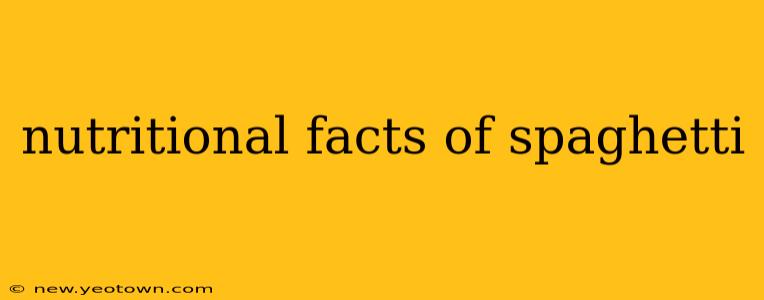Spaghetti, the quintessential Italian comfort food, is more than just a tasty treat. Understanding its nutritional profile can help you make informed choices about incorporating it into your diet. Let's embark on a delicious journey, unraveling the nutritional facts of this beloved pasta.
Imagine a warm, inviting plate of spaghetti, glistening with a rich tomato sauce, or perhaps tossed in a light pesto. This simple dish holds a surprisingly complex nutritional story. While the specific nutritional content can vary based on the type of spaghetti (whole wheat, enriched, etc.) and the serving size, we can explore the general nutritional landscape. This exploration will address frequently asked questions to give you a comprehensive understanding.
What are the macronutrients in a serving of spaghetti?
A typical serving of cooked spaghetti (around 1 cup or 56 grams of dry weight) provides a substantial amount of carbohydrates, a moderate amount of protein, and a negligible amount of fat. The majority of its calories come from carbohydrates, making it a primary source of energy. The exact macronutrient breakdown varies depending on the type of spaghetti; whole wheat versions offer more fiber and slightly less carbohydrates than their refined counterparts.
How many calories are in a serving of spaghetti?
The caloric content of spaghetti varies depending on the type and serving size. A cup of cooked enriched spaghetti typically contains around 200-220 calories. However, adding sauce or other ingredients significantly impacts the overall calorie count. A creamy Alfredo sauce, for example, will drastically increase the calorie count compared to a simple tomato-based sauce.
Is spaghetti a good source of protein?
While not a primary protein source, spaghetti does offer a moderate amount of protein per serving. This protein content is crucial for building and repairing tissues. Again, the protein content can vary depending on the type of pasta; some enriched varieties have slightly higher protein levels than others. It's important to remember that spaghetti is best enjoyed as part of a balanced meal that incorporates other protein sources like lean meats, beans, or lentils.
What are the vitamins and minerals in spaghetti?
Spaghetti, particularly enriched varieties, provides a good source of several essential vitamins and minerals. These include iron, which is crucial for red blood cell production, and several B vitamins, essential for energy metabolism and nerve function. Whole wheat spaghetti boasts even more fiber, along with additional vitamins and minerals compared to its refined counterparts.
Is spaghetti good for weight loss?
The suitability of spaghetti for weight loss depends greatly on the context of its consumption. In moderation, as part of a balanced diet, spaghetti can be included in a weight loss plan. However, it's crucial to watch your portion sizes and choose whole wheat varieties for added fiber, which can contribute to satiety and help regulate blood sugar levels. High-calorie sauces should be used sparingly to minimize overall calorie intake.
What are the differences between whole wheat and white spaghetti?
The key difference lies in the processing of the wheat. Whole wheat spaghetti retains the entire wheat kernel (bran, germ, and endosperm), leading to a higher fiber content, more vitamins, minerals, and a slightly nuttier flavor. White spaghetti, on the other hand, is made from refined wheat flour, which strips away the bran and germ, resulting in a lower fiber content and fewer nutrients. The choice depends on individual dietary preferences and nutritional goals.
Can spaghetti be part of a healthy diet?
Absolutely! Spaghetti, especially whole wheat spaghetti, can be a valuable part of a balanced and nutritious diet. The key is mindful consumption. Choosing appropriate portion sizes, pairing it with nutrient-rich ingredients (vegetables, lean proteins), and selecting whole wheat varieties over refined options can help maximize its nutritional benefits while minimizing any potential drawbacks. Enjoy your spaghetti responsibly and savor the taste knowing that it can be a delightful and nutritious part of a well-rounded meal plan.

